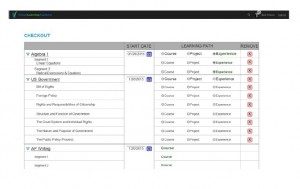Pushing the Envelope with Student Centered Learning at VLACS
CompetencyWorks Blog

There are a handful of schools pushing past the concept of organizing learning based on credits to take advantage of the incredible flexibility that a framework of competencies of standards allows. Virtual Learning Academy Charter School (VLACS) is one of these innovators, showing us a possible direction for a personalized education system. (Chugach School District and Bronx Arena are other credit-busters.)
I recently spoke with Steve Kossakoski, CEO of VLACS, to learn about how they are working to redefine what it means to learn and go to school in the twenty-first century.
Reflecting on Innovation and the Power of Student-Centered Learning
Kossakoski started off the conversation explaining that by embracing the tenets of student-centered learning (personalized; competency-based; anytime, anywhere; and learners exerting ownership over their learning), they have started to push the envelope of their own thinking.
He remarked, “In my opinion, competency-based learning alone will not significantly change the model or the outcomes of today’s school. There are a lot of schools converting to competency-based frameworks, but without significant structural change, it will be difficult for these schools to take advantage of the opportunities that a student-centered learning model offers. For example, some schools have created broad overarching competencies while curriculum and instruction still looks the same. Other schools are integrating competency-based approaches within the traditional curriculum while continuing to expect that all learners will master the same set of competencies within a 180-day academic year. I’m a bit concerned that schools will only tinker around the edges of possibility and end up reinventing the traditional model but with a new coat of paint.”
“As an online school, we have a great deal of freedom to innovate, so, as we designed our services based on the tenets of student-centered learning, we worked from the perspective of what’s possible when the limitations of a time and place-based system are removed. We realized that until you provide students with the opportunity to design their own learning pathways, they won’t really own their learning. Offering learners a choice of courses and projects provides kids with some ownership. But how much ownership is it, really?”
He explained that they began to examine the continuum from individualization to personalization. He explained the difference, “Schools tend to individualize by providing learners with a limited set of options. However, personalization requires engaging the learners in a conversation and asking, ‘What do you want to do? Where and how do you want to learn?’ Learners may want to learn in a traditional class, online, in the community, through self-study, or by participating in a project. We are trying to dig deeper into what it means to personalize learning and to extend the capability of our school to fully personalize education. We don’t want learning to be bound by the courses we offer.”

“The common definition of anytime anywhere learning is based on the notion that students can learn in school or at home at any time of the day using a digital or online tool. However, anytime anywhere learning could mean that students are learning while involved in a community service activity on the weekend or while working as an entry-level computer programmer in the evening. Student-centered learning can expand the possibilities for learning and could redefine what it means to go to school. We live in exciting times where technology and society are rapidly changing, and my hope is that we seize the opportunity that student-centered learning provides to transform education in the interest of doing what’s best for learners.”
Moving Beyond Online Learning
Kossakoski pointed to a slide that explained how VLACS is expanding options so students can begin to design their learning based on what they want to learn and how they want to learn it. VLACS is creating a four-part model where learners have an almost limitless combination of opportunities to create rigorous and engaging learning scenarios.
Learning Through College: VLACS has just launched the LTCollege program. It’s the first competency-based, open enrollment, self-paced opportunity for learners to take advantage of college courses. (It came about in a VLACS partnership with Southern New Hampshire University, a leader in competency-based higher education.) The LTCollege program is designed to be a competency-based early college program so learners can potentially earn an Associate’s degree while attending high school. LACS assigns an early college coach to every student who elects to enroll in the full-year or Associate’s degree option.
I do believe this is the first completely online early college partnership in the nation that allows high school students to learn at their own pace.
Learners can also take just a few college courses, a la carte style. It’s an important addition as learners across New Hampshire can now advance beyond the limit of K-12 with courses that have been calibrated with a university. Kossakoski added that LTCollege is available to high school students in any state.
The partnership between VLACS and SNHU to build early college capacity starts with SNHU sharing their online course content to be reviewed by a VLACS design team make sure it is developmentally appropriate. For example, a book in a college course may not be appropriate for sixteen year old. VLACS then sends back its recommended revisions to SNHU for approval. Once approved, VLACS hires instructors who meet the SNHU requirements to be adjunct faculty.
Learning Through Projects: In order to move away from courses as the only way for learners to access learning, VLACS is creating a huge pool of three-to-four-week projects that learners can select to learn and demonstrate their learning. The projects are based in real-world scenarios and integrate professional expectations. A team of VLACS performance assessment designers has been working with Quality Performance Assessments to develop these unique projects.
Kossakoski explained that, “If students are working on a science project, they are going to be assessed on the science standards. The expectation is that the project itself will meet professional expectations in terms of writing and format. It’s either acceptable or not. The teachers will assess the specific science competencies using rubrics.”
VLACS is using Show Evidence as a platform for scoring projects and providing feedback. So far they’ve developed 100 projects and want to develop another 800 or so. Kossakoski noted, “This is still an individualized approach, as we are building the projects for learners to choose from. However, the greater the variety, the more we can engage with learners about how they want to learn and offer meaningful opportunities.”
Learning Through Experience: By creating an opportunity for learners to learn through internships, community service, independent study, travel, or other experiences with the support of instructors, VLACS is seeking to develop highly personalized options, as well. Kossakoski noted, “We expect that students will design and participate in many exciting and unique learning experiences while under the direction of a certified instructor.”

Putting it all together: “I believe that the most exciting part of our new learning model is that there are an almost unlimited number of combinations from which students can choose,” Kossakoski stated. As illustrated in this image, students will have the option to meet competencies in the learning environment that best fits their needs. This may mean that a students starts their study of English by interning at a local newspaper (LTE), completing two career related projects (LTP), mastering two English competencies while taking a college course, and completing the competency group known as English I by enrolling in two modules of an online course.
Filling a Backpack of Learning

Kossakoski then explained that VLACS is in the process of creating a comprehensive competency map. Learners can fill their backpack (think of it as a shopping cart) by selecting the competencies they are going to focus on and how they are going to learn (through courses, college, projects, or experience). VLACS then assigns the learners to an instructor who can guide them through the curriculum, help them select a project, coach them as needed, and, most importantly, provide ongoing feedback and assessment. Kossakoski explained, “At first, teachers will act a as generalist to help learners get started. They may need to bring in other teachers later on if there is a need for specialist knowledge.”
This took me a couple of minutes to get my head around it – I had to rethink what it means to have a relationship with a student and how it is created in an online school as compared to face-to-face environment. I also had to shake out a lot of the spider webs that still cling to my idea of how schools mediate the relationship of learners to their education. I love it when I encounter something that makes me say, “Wait, give me a minute,” because I know the school has broken through some organizing principles of the standardized system.
Learners have the opportunity to select the order in which they meet competencies as guided by their own personal learning path. Dashboards will help them monitor pace, progress, and completion of the competencies.

VLACS knows it is still operating in the midst of a standardized system that uses the currency of credits, and are prepared to translate the competency groupings into courses for learners making a transition to another school or college. What VLACS is doing is certifying that learners have demonstrated learning for the standards within the course. When schools are certifying that learners are learning, they are demonstrating accountability.
VLACS is now working with Ascendle and Motivis to create the information management system to support their enhanced approach. (Brian Peddle and the Motivis team developed the College for American information management system and is now playing a catalytic role in sharing insights between higher education and K12). Kossakoski believes that the agile development process and working closely with Ascendle and Motivis to design modules based on the SalesForce platform is the way to go. The process is very rapid, and schools can develop modules that meet their needs as well as share them with others.
Kossaskoski shared several insights into the challenge schools are facing as they try to move from the SIS programs developed for the standardized system. “There is an enormous risk in trying to build the entire system from scratch. We are all learning – we don’t know exactly what our information management needs will be a year from now as we continue innovating. Working with small companies is a risk because they may not be there next year. There is an even bigger risk of trying to get the big SIS vendors to create a system that will meet all of our needs.”
He went on to add, “We have to be very careful about the specifications, because once the big SIS vendors develop a suitable system, schools will be forced to accept their model. I think a modular approach will provide us with the opportunity to develop a system that can evolve with as the field of student-centered learning matures.”
Future Focus of VLACS
VLACS has an enormous vision for the role it can play as New Hampshire’s online school. There are plans to expand to elementary school; to adult education for adults over twenty-one years who don’t have a diploma, received a diploma but not the skills (the tragedy of the Carnegie Unit), or want to build up marketable skills such as coding; and to support high school learners who need a transition year to help them build skills, mature, or clarify what they want to achieve.
Kossakoski enthused, “One day I hope we can say that student centered learning made it possible for students to learn whenever and wherever their interests and passions take them.”